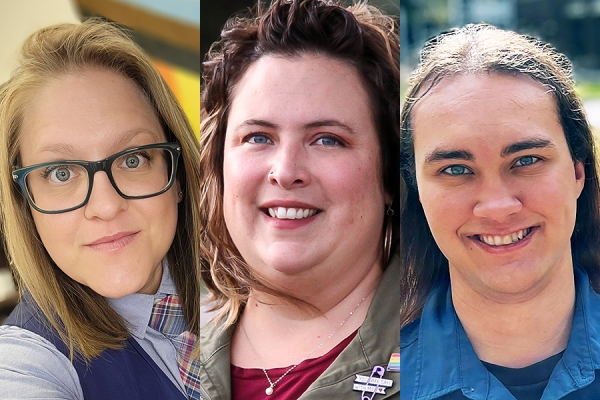 Prop master Valerie Bonasso enlists student help to build a tree for the set of the University Players production of "Little Women."
Prop master Valerie Bonasso enlists student help to build a tree for the set of the University Players production of "Little Women."
Well before the actors hit the stage, students and staff at University Players have long been bustling behind the scenes to bring the show to life.
From lighting, to set design, props, and costumes, dramatic arts students participating in labs and their instructors have been hard at work to transform the Essex Hall Theatre into 1860s Concord, Mass. for UP’s latest production of Little Women, which follows the journey of the March sisters — Meg, Jo, Beth, and Amy — as they move through life navigating dreams, loss, and love amidst the backdrop of the American Civil War era.
Setting the stage
As technical and production co-ordinator, Dave Gauthier’s role is to help facilitate the show from start to finish, assisting other departments to help co-ordinate and keep the project on time, which starts with scenic designs and builds.
Gauthier said the scenic designer for the show will decide with the director what the stage will look like. This works as a starting point for the builders, props, and lighting.
“I’ll assist the builder in breaking down the designs and making sense of how we’re going to approach and install it. So myself and Justin Yelle, our master carpenter, work together to plan through a lot of those elements. And then I assist him in the installation of it as well,” Gauthier explained.
For Little Women, the floor of the stage is one large piece of paper, as though the characters leapt off the pages of a book. To bring that vision to life, Gauthier said there was a lot of out-of-the-box thinking involved.
“We used a product called Masonite on the upstage and (Yelle) had to cut it into different sections and form a bend. That upstage part of the paper is made up of about four or five different sheets that are all taped in seam together and painted into one seamless pattern,” Gauthier said.
The result turned out nearly identical to the design renderings.
“I always pull up the original renderings that we looked at when we first started the process. And I compare it to the look of the stage,” he said. “And it's unbelievable how close they are most of the time. That’s what we take pride in is trying to realize a vision of a designer to be as accurate as possible.”
Gauthier also oversees the sound design and lighting installation, working with a designer who will choose specific colours to complement other design elements in the show, such as paint and costumes.
“Students work with me to install all of the technical components,” Gauthier said. “They hang all the lights with me, they help focus them. Whatever technical requirements are needed on the show, the students work with me during lighting lab to help with that.”
Lighting, set design, and sound all work together to establish a show’s feel.
“In Little Women, there are a lot of musical pieces and projection work during the transmissions, but in other shows it can be extremely complex where there’s like a full soundscape that doesn’t end for the entire show. It all depends on what the director is looking for.”
Props to design
You might find props master Valerie Bonasso scouring through a thrift store or refurbishing and creating new items in the scene shop.
“I oversee either finding, making, or pulling from stock, all the props and set decoration that we need for the shows. I do a lot of the work in the prop shop with lab students and Ignite students,” said Bonasso.
After reading the script and establishing the show’s aesthetic with the set designer, Bonasso will get to work, and for a period piece like Little Women, a lot of research goes into sourcing the props that will help establish the style of the show.
“Any kind of object that gets used, we have to know if it existed back then, and what it looked like when and how they used it,” she said. “So sometimes things that we use now don’t get used in the same way as they did back then.
“Then we just go to the shop, and we start either finding things that maybe we already have in stock, or finding things at second-hand stores or things that you can still find nowadays, or things that have to be adapted to make them look older.”
Items that either didn’t exist or can’t be found or sourced will need to be made from scratch, which are then created in the scene shop with the help of some innovative thinking.
For example, a fixture of the Little Women set is a giant tree, which Bonasso said was a “labour of love” to bring to the stage.
“We had to figure out how we were going to build a tree that looked realistic. So we ended up using PVC pipes of all different diameters and reducers to make the pipes get smaller as the branches get further away from the trunk and then the final tips of the branches are just pieces of wire wrapped in aluminum to give that feeling of the pointy ends of branches,” she explained.
“I feel bad for any plumber in the city right now because I wiped out almost every hardware store of PVC and connectors.”
Style for the ages
Costumes tell an important part of the story and characters, with subtle hints about growth and personality embedded into each look.
“We try to give our students a historically accurate costume to move in because it affects every aspect of their character,” said Kristen Siapas, UP marketing and public relations co-ordinator.
“So, you’ll see in Little Women that we have students that are wearing corsets. And Aunt March has a giant hoop skirt. And the girls themselves, as we see them through this whole coming-of-age story. You’ll see their dresses change too, so Amy’s dress gets longer and she adds a petticoat, Joe’s corset gets tighter, and she starts to stand more straight, and you can see how her age is affecting her through those costumes.”
She said University Players has a huge inventory production can pull pieces from as well, so costume design can range from building clothes outright to altering what is already available. Students in the costume lab will work with designer Agatha Knelsen putting thread to needle to build out the wardrobe.
“Students who don’t even have any sewing experience whatsoever, learn the basics of how to thread a needle, how to use a sewing machine, all of those things, and they get to work, building and making the costumes right away,” Siapas said.
In addition to creating the costumes, learning to care for the pieces is another important part of backstage work.
“We have students working backstage as dressers, where they learn more about the care of the costumes, how to interact with actors, how to do quick change different things about laundry, you know how we take care of costumes so that they last a full run, that kind of thing,” she said. “In our production of Macbeth, our props and paint students were learning how to make fake blood, and our costume students were learning how to get it out of clothes.”
Students at the School of Dramatic Arts can participate in these labs as early as their first year, choosing from props, lighting, costumes, carpentry, publicity, or running the show backstage which involves operating the lighting console, sound console, and assisting with transitions and movement of set pieces during the play.
After months of preparation from the actors getting into character to take the stage, to those working behind it, Little Women will have its opening night Friday, March 15. Admission starts at $20 with a student rate of $10; available for purchase online.




